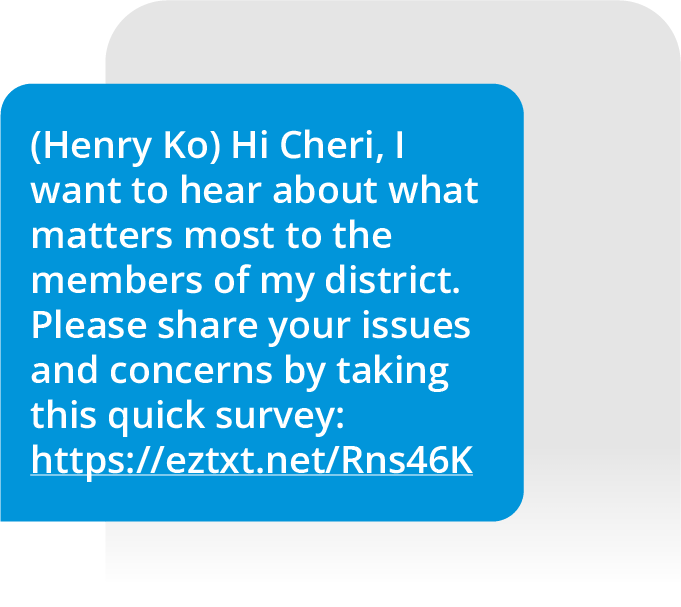Pivoting from Election Campaign Texting to Elected Office Texting
Maintain engaging constituent communication post-election win with these tips

So you’ve run a successful political campaign and been elected to office. First, you celebrate, and then ask yourself, “What’s next?”
Continue sending engaging constituent communication with elected office texting — these tips simplify the transition!
Why Is Constituent Communication Essential for Elected Officials?
Constituent communication is essential for elected officials because it fosters trust, accountability, and transparency with voters. It provides a meaningful avenue for getting information, maintaining engagement, showcasing your work in the office, and garnering feedback. Plus, it allows elected officials to stay connected to the needs and interests of all constituents — not only the people who voted them into office.
Benefits of Elected Office Texting
There are several methods to communicate with constituents, but texting is one of the most important. What are the benefits of text messaging for politicians? The benefits of text messaging for politicians are increased engagement, immediacy, and wider reach.
Increased Engagement
As an elected official, you want to ensure that your constituents are engaged with the work that you’re doing and the policies you support. Texting is the best way to boost engagement, with six to eight times higher engagement rates than email. This is because texting is increasingly becoming people’s preferred communication channel over email and phone calls. So with elected office texting, you’re reaching contacts how they want to be reached, making them more inclined to interact.
Immediacy
Texting is immediate, and the statistics speak for themselves: Most people open texts within 90 seconds of receiving them. This means that your messages, whether community updates, event invites, or emergency alerts, will be seen — and acted upon — quickly.
Wider Reach
If you’re not texting constituents, you’re missing out on a large portion of the population. SMS messages have a 98% open rate. Conversely, emails only have an 18% open rate, and most people don’t answer phone calls from unknown numbers. With texts, you can reach more people — it’s that simple.
What Is Elected Office Texting, and How Does It Differ from Campaign Texting?
First, let’s cover what is elected office texting and how it differs from campaign texting.
Elected office texting refers to using text messaging as a communication tool by officials after they have been elected to office. Political campaign messaging refers to texting to rally support and mobilize voters during an election cycle, whether for a specific candidate, ballot item, or getting out the vote.
As you can see, the difference is that one is used for constituent communication when someone is in office, while the other is used for campaigning and voter outreach for Election Day. Both prompt engagement but for different reasons. Unlike campaign texting, which focuses on rallying support and mobilizing voters during an election cycle, elected office texting centers on ongoing engagement with constituents to keep them informed, gather feedback, and address their concerns.

How to Transition from Political Campaign Messaging to Elected Office Texting
Transitioning from campaign messaging to elected office texting is more intuitive than you think. That’s because you’ve already laid the foundation for effective communication during your campaign.
So, what role does political campaign messaging play in elected office texting? Political campaign messaging plays a role in elected office texting. It has established a contact list, segmented contacts according to certain locations and/or traits, and cultivated relationships with supporters. All you need to do is leverage these foundational elements to continue communicating and engaging with constituents — and we’ll tell you how with helpful strategies.
Say Thank You
Saying thank you is an important but often overlooked first step when pivoting to a political texting strategy in office. Expressing gratitude to supporters maintains constituent communication and provides a necessary transition from campaign messaging to elected office texts. It marks the successful end of one part of your journey and signals the beginning of another: your role as an elected official.
Additionally, sending an SMS thank-you message shows constituents that you acknowledge their integral part in the democratic process. Make sure to let contacts know that this role can and should continue through interacting with your office’s future text messages.
Review and Adjust Contact Segments
You’ve already done much of the hard work of gathering and segmenting SMS subscribers, but now it’s time to review each segment and adjust as needed. For example, you might not need to bucket contacts by voting history or their level of support for you as a candidate, as these aren’t necessarily important for current constituent communication. Instead, you might focus segmentation tactics more on location (drilling down to state, city, or zip code) and top concerns for targeted messaging.
But reviewing and adjusting your current text list doesn’t mean your list is complete. You should always promote your SMS subscriber list to constituents through tools like QR codes, texting a keyword to a short code, click-to-text generators, and more. Growing your contact base is essential for reaching out to more people and connecting with constituents with varying backgrounds, perspectives, and concerns.
Obtain Feedback
Building trust with constituents starts with soliciting feedback. Even though you probably have a good idea of the local concerns, it’s important to ask people specifically. This gives community members more buy-in with government processes (boosting engagement) and provides your office with essential information that can help guide policy goals and initiatives.

Asking for feedback via text is easy. Send constituents a link to an online survey, share a text poll, or ask open-ended questions using two-way texting. Get a high response rate by reiterating the importance of making their voice heard, emphasizing the opportunity to influence the policies and actions your newly elected role will support, and following these text survey best practices.
Define Goals and Strategies
Now it’s time to define the goals of your political texting strategy. Goals will differ depending on the type of messaging. For example, you could set up an automated text campaign for an upcoming speaking event, the goal of which would be ticket purchases, event registration, or volunteer sign-ups. Another example might be sharing details about a recent initiative you supported, where the goal is for contacts to click a text link to view more information on your website.
While you might think that simply "communication" is the goal for elected office texting, to drive engagement and boost trust in your office, you need to set clear goals, measure them, and tweak accordingly (more on that later).
Start Messaging Constituents
You’ll most likely use several political outreach strategies in office: updating and informing, sending alerts, and engaging via text.
Update and Inform
Updating and informing is part of transparent constituent communication and allows you to share prominent policy pushes, bills you have signed, responses concerning legislation, and so on. These types of texts might also include highlighting and amplifying constituent voices by sharing real stories of community members.

Send Urgent Alerts
Sometimes you must share urgent information about security and safety issues, like power outages or weather incidents. The best way to communicate quickly is through text.
Engage Citizens
Engaging constituents is key to a successful governing body. The more they engage, the better you’ll understand your community's wants and needs.
How can elected officials leverage text messaging for constituent engagement? Elected officials can leverage text messaging for constituent engagement in various ways. As mentioned, gathering feedback is crucial for constituents to feel part of the democratic process. But you can also consider sending text invites for virtual town halls, utilizing conversational texting to create personal connections, and leveraging data to send targeted messages to specific subsets of constituents.
Track, Analyze, and Tweak
The best political texting strategy will not just set goals but track them and adjust the strategy accordingly. Your text marketing platform should offer tracking and reporting tools to measure click-through rates, opt-in rates (for your list growth program), opt-out rates, bounce rates, and other contact interactions. Additionally, for SMS event texts, you’ll want to track registration and attendance.
As you monitor each texting strategy, you can pinpoint what’s working and what’s not, allowing you to tweak and test to get the most out of this communication method.
Continue Connecting with Constituents
Texting is undoubtedly the not-so-secret solution to providing engaging, transparent, and accessible constituent communication. Continue connecting with your audience with EZ Texting, which offers robust contact management tools, text automation, AI tools, and more to simplify and optimize your mobile communication efforts. See for yourself with our 14-day free trial!
FAQs
Effective political outreach strategies through text messaging might include obtaining feedback, using data to tailor texts to specific subsets of contacts, updating and informing constituents, sending alerts, and more. All political outreach strategies should engage contacts through microtargeting, conversational texting, and surveys to help constituents stay involved in the democratic process.
Elected officials can develop a successful political texting strategy by establishing clear goals, such as event registration and attendance, gathering feedback, increasing awareness, etc. These goals will guide each strategy and help elected officials monitor their performance more effectively. Track goals to optimize each SMS strategy.
See other resources related to:
